WMG News
Reusable and customised facemask to keep healthcare workers safe thanks to digital supply-chain
 Throughout the pandemic the filtering facepiece 3 respirator (FFP3) mask was heavily in demand, as it is the most widely used respiratory protective equipment in UK healthcare system. However, according to a study with health workers from 32 hospitals, the overall fit-testing pass rates had a mean pass rate of 81%.
Throughout the pandemic the filtering facepiece 3 respirator (FFP3) mask was heavily in demand, as it is the most widely used respiratory protective equipment in UK healthcare system. However, according to a study with health workers from 32 hospitals, the overall fit-testing pass rates had a mean pass rate of 81%.
MyMaskFit with their NHS Nurse co-Founder saw this statistic in reality in setting up the COVID-19 Wards, and with inspiration from the Ventilator Challenge UK they have created a reusable, customised facemask to protect medical workers during and after the pandemic.
The mask is unique as it has:
§ Fully customised fit according to individual’s face. This will ensure a high fit-testing pass rate and better protection.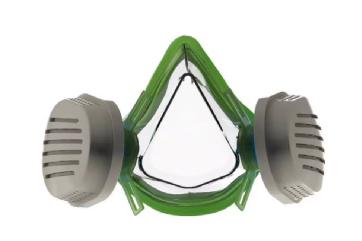
§ Different from the traditional one fits all masks, customised mask will also provide the most comfortable wearing experience that enable clinical workers wearing them for long time.
§ Local 3D printing supply chain to ensure a fast and flexible reaction to the demand with short lead time.
However, to ensure MyMaskFit could be rolled out and mass produced it was important to secure a sustainable supply chain. This is where the WMG Supply Chain Research Group stepped in and helped MyMaskFit to create a digital solution, taking advantage of emerging distributed manufacturing.
Distributed manufacturing consists of using global and remote expertise, producing parts locally and diversifying supplier network productions, researchers from WMG decided to use distributed manufacturing to create a digital supply-chain marketplace, which is attractive to buyers and suppliers, as it uses the insight gained from other marketplace examples to address known barriers and issues. This means that companies can transform customer feedback into designs and products that can be achieved within days through such a dynamic and distributed supply chain.
The WMG Accelerator Team also helped, by leveraging their existing knowledge learned from UK Collaborative Commerce Marketplace (UKCCM). UKCCM is a digital marketplace created by WMG Accelerator Team, which aims to increase sales and lower costs through providing easy access to the core competences and capabilities of small and medium-sized enterprises.
MyMaskFits was then able to meet the classification of cloud-additive manufacturing with a touch of the platform's support (marketplace) to amplify the on-demand supply chain to a larger scale.
Carl Che from the WMG SCRG at the University of Warwick comments: “We are glad that our distributed manufacturing archetype and marketplace archetype helped MyMaskFit to form their business model from academic side. It feels great knowing a better mask can potentially help more NHS workers or even save more lives.
“From a macro perspective, two separated models (distributed manufacturing and B2B marketplace) perfectly help each other out. This project can potentially sketch out an emerging pattern of the future manufacturing in the UK.”
Paul Perera from MyMaskFits comments: “Our mask is unique as it is reusable and customisable, however in order for it to be mass produced and manufactured easily we needed a sustainable supply-chain in place.
“WMG at the University of Warwick have helped us meet our customer’s needs and expectations by helping us secure a sustainable and digital supply-chain, this means we can easily check our suppliers availability and prices and provide MyMaskFit quickly and at a competitive price.”
ENDS
NOTES TO EDITORS
High-res images available at:
https://warwick.ac.uk/services/communications/medialibrary/images/november_2021/mask_on_face.jpg
Caption: The MyMaskFit reusable and customised facemask
Credit: MyMaskFit Photographer: Ed Felton
https://warwick.ac.uk/services/communications/medialibrary/images/november_2021/mask_1.jpg
Caption: The MyMaskFit reusable and customised facemask
Credit: MyMaskFit Photographer: Ed Felton
https://warwick.ac.uk/services/communications/medialibrary/images/november_2021/mask_4.png
Caption: The MyMaskFit reusable and customised facemask
Credit: MyMaskFit Photographer: Ed Felton
5 April 2022
The University of Warwick supports RIFT Technology with a greener cost-effective electric motor
A cheaper and more environmentally friendly electric motor for electric vehicles is a step closer to market with the support of WMG at the University of Warwick.
WMG has provided valuable knowledge and expertise in developing a UK focused, cost-effective production and supply chain for RIFT (Reduced  Induction Field Torque) Technology’s development of RIFT-10; a design for electric motor drives that reduces copper and magnet weight reduction by around 50% and lower cost by 75%.
Induction Field Torque) Technology’s development of RIFT-10; a design for electric motor drives that reduces copper and magnet weight reduction by around 50% and lower cost by 75%.
The aim of the project was to help RIFT Technology; an R&D company bringing a product to market for the first time, advance RIFT-10 to a higher manufacturing readiness level (MRL 7), to get the motor closer to production, by rooting the supply chain in the UK, rather than abroad (given the disruption to supply caused by the pandemic) and supporting production of trial units.
WMG, is committed to delivering UK economic impact and achieving net-zero by supporting industry in accelerating new concepts to commercial reality. This supports the University of Warwick’s approach to sustainability - the Way to Sustainable – which focuses on the real-life implications of creating a sustainable future and the practical challenges of getting there - prioritising research expertise, sustainability in the curriculum, and developing solutions for the benefit of industry and society.
The team of experts at the University has facilitated the RIFT-10 project to deliver on creating revenue, jobs, CO2 reduction, and supply chain growth in the UK.
RIFT Technology has developed the RIFT 10-30 kW motor (RIFT-10) by taking an exciting innovation from their sister business (RIFT Actuators) and working with APC and the Niche Vehicle Network to get the motor to working prototype stage (installed on a G-Whiz). The novel electric motor configuration is proven to generate 10-30kW of power, torque from 0-400Nm and up to 10,000RPM as demonstrated with a prototype vehicle.
The RIFT 10 motor demonstrated unique advantages over conventional EV motors:
Environmental benefits of the project:
· The low sales cost and attractive features of RIFT-10 enable greater/earlier market adoption of EUV’s, resulting in a reduction of CO2 production over ICE vehicles.
· A RIFT-10 weight saving and efficiency over competing EV motor designs increase vehicle range, resulting in less energy usage over alternatives.
· With RIFT-10, equivalent power output is achieved using fewer raw materials (i.e., 85% reduced copper weight and ~85% reduced magnet volume), resulting in less earth material usage as well as fewer material costs.
· Less materials usage results in an estimated 75% reduction in CO2 produced during manufacture. Planned production efficiencies also lead to further CO2 reductions. An estimated 612,000 Tonnes of CO2 would be saved by year 5.
· Development of an EV motors supply chain in the UK for a UK and EU market reduces international shipping of components thus reduces related CO2 production.
Social benefits of the project:
· RIFT-10 creates/safe-guards 50+ much needed and good-quality manufacturing, sales, administration and R&D jobs in the Malvern area with an estimated X14 more UK jobs across the supply chain (over 5-years).
· Growth of RIFT-10 addresses the government’s priority area of ‘Smart Cities’ by allowing smart monitoring of vehicle fleets efficiency performance, usage and other data points. The use of the Internet of Things and resulting analysis can only be as strong as the data input. Traditional alternatives offer no smart functionality.
James Black, WMG Innovation Manager at the University of Warwick said, “The Covid-19 pandemic has been particularly difficult for SMEs and R&D-focused organisations that have previously relied on face-to-face networking events to find new partners, investors, and customers.
“WMG’s network means we’re in a great position to connect UK companies together to help them accelerate their product to the market, and we’re delighted that RIFT Technology has benefited from our extensive background for practical supply chain solutions that have delivered economic and societal value to the project.”
James O’Donnell, Technical Manager from RIFT Technology said, “As a research and development company bringing a product to market for the first time, RIFT Technology needed to bridge the gap between prototype and small-scale production. We had to answer difficult questions such as what to make and what to buy, high level questions such as how to develop a supply chain strategy and practical questions such as how best to select suppliers.
“With a unique blend of academic expertise and industrial experience from the University of Warwick, WMG’s Supply Chain and Operations Group were able to support us in our journey.”
The project took place during the pandemic, meaning several online workshops were carried out targeting topics such as strategic management, supplier selection and decision-making, and end-of-life strategies.
For further stories, click here.
ENDS
4 April 2022
Clean Transport Accelerator launched by NatWest and University of Warwick to help SMEs fast-track their innovations
- NatWest and WMG, a department at the University of Warwick, are inviting businesses that are creating the next generation of clean green transport to apply to their new accelerator
- Businesses will receive support to fast-track their innovations, including easy access to clean transport experts and equipment, exclusive 1:1 coaching sessions, and access to growth funding
- The Clean Transport Accelerator is a fully-funded programme and will help the UK be a green leader in carbon-neutral transport for future mobility, helping businesses bring their innovations to the market quicker
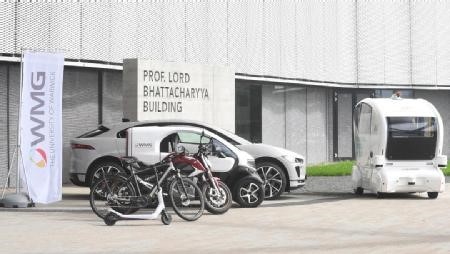 With transport being the largest carbon emitting sector in the UK, a partnership between NatWest and WMG at the University of Warwick has led to the launch of the Clean Transport Accelerator. It will support businesses which are part of the mobility sector to develop products and services that will play their part in achieving the UK’s net-zero goals.
With transport being the largest carbon emitting sector in the UK, a partnership between NatWest and WMG at the University of Warwick has led to the launch of the Clean Transport Accelerator. It will support businesses which are part of the mobility sector to develop products and services that will play their part in achieving the UK’s net-zero goals.
The first cohort of the programme will help 10-15 businesses through education, events, networking and coaching. They will also have access to experts and equipment to help them accelerate their innovations to the market and demonstrate an impact in the pursuit of net zero goals.
Applicants can be from anywhere across the UK and cover a broad range of businesses, whether they are based within supply chains, are fuel providers, want to develop new means of transport, or be focused on specific transport such as light rail, cargo delivery or scooters.
The programme will be delivered jointly by NatWest and WMG, University of Warwick. NatWest will provide an enterprise acceleration manager with 1:1 coaching, access to their accelerator growth events and access to work space, as well as learning hubs at the University of Warwick and Birmingham.
The University of Warwick will provide access to clean energy, manufacturing, automotive and connected experts at WMG and their HVMC (High Value Manufacturing Catapult), as well as the tools to validate and test any equipment designed by the businesses and access to co-working spaces on Campus.
NatWest supported over 55,000 entrepreneurs in 2021 and has 13 accelerator hubs across the UK. Businesses with high growth potential benefit from a range of support through the accelerators. This includes coaching, community, access to a wide network and thought leadership content. NatWest accelerators are keen to attract more female and BAME led businesses as well as companies outside London and the South East. Any business keen to take its next step for growth should consider applying to the NatWest accelerator scheme.
The Clean Transport Accelerator news follows the recent launch of NatWest’s green loans for SMEs and green asset finance through Lombard. Companies can access funds with no arrangement fee to help them transition to more sustainable working practices. The bank has pledged to lend £100 billion by 2025 to businesses looking to invest in being greener. NatWest’s Springboard to Sustainability report, published in October 2021, found that half the UK’s carbon reduction ambition can be delivered by the SME sector and the Clean Transport Accelerator is the bank’s latest offering to help UK SMEs pursue this goal.
Professor David Greenwood, CEO of the High Value Manufacturing Catapult (HVMC) at WMG, University of Warwick comments:
“The drive to net zero has opened up new and exciting opportunities for innovation in the transport sector. Together with NatWest, we’d like to ensure that the UK delivers economic benefits as well as environmental benefits as we meet this critical objective. This programme is aimed to support small and innovative companies as they build and scale up their products, services and business models.”
Richard Hill, Head of Automotive and Manufacturing at NatWest, said:
“NatWest has set out a clear ambition to play a leading role in helping to address the climate challenge, and so we are thrilled to be working with the University of Warwick to offer clean transport businesses a fast-track to delivering on the UK’s green goals.
“Packed with experts, access to equipment, networking opportunities and funding advice, the Clean Transport Accelerator is a must for any business keen to scale up their next step. I look forward to seeing the innovative and exciting businesses that we support.”
Businesses can apply for the Clean Transport Accelerator here: Registration Portal
Where it says ‘Voucher Code’ please enter ‘CleanTransport01/2022’
The deadline for applications is the 11th April 2022.
ENDS
22 FEBRUARY 2022
NOTES TO EDITORS
High-res image available at:
https://warwick.ac.uk/services/communications/medialibrary/images/february_2022/electric_vehicles_outside_wmg_.jpg
Caption: Electric Vehicles outside WMG, University of Warwick
Credit: WMG, University of Warwick
For more information and to apply to the Clean Transport Accelerator visit here
For more information on NatWest’s nationwide accelerators visit here
For more information on NatWest’s green loans visit here
For further information please contact:
Alice Scott
Media Relations Manager – Science
University of Warwick
Tel: +44 (0) 7920 531 221
E-mail: alice.j.scott@warwick.ac.uk
Laura Blumenthal
Media Relations Manager – NatWest
Tel: 07947974464
E-mail: laura.blumenthal@natwest.com
About NatWest Group
NatWest Group is a relationship bank for a digital world. We champion potential; breaking down barriers and building financial confidence so the 19 million people, families and businesses we serve in communities throughout the UK and Ireland can rebuild and thrive. If our customers succeed, so will we.
About WMG, University of Warwick
WMG is a world leading research and education group, transforming organisations and driving innovation through a unique combination of collaborative research and development, and pioneering education programmes.
As an international role model for successful partnerships between academia and the private and public sectors, WMG develops advancements nationally and globally, in applied science, technology and engineering, to deliver real impact to economic growth, society and the environment.
WMG’s education programmes focus on lifelong learning of the brightest talent, from the WMG Academies for Young Engineers, degree apprenticeships, undergraduate and postgraduate, through to professional programmes.
An academic department of the University of Warwick, and a centre for the HVM Catapult, WMG was founded by the late Professor Lord Kumar Bhattacharyya in 1980 to help reinvigorate UK manufacturing and improve competitiveness through innovation and skills development.
New Loqski glass fibre ski lock to keep your skis safe this season
- With winter being the ski season many skiers will be off on holiday, possibly taking their own expensive skis
- When leaving your skis for a break from the slopes they’re at risk of being taken intentionally or unintentionally from the racks, however Loqski have come up with a solution made and manufactured in the UK
- Loqski is a pocketable device locking skis and poles together, WMG at the University of Warwick have helped them manufacture the locks affordably and sustainably
- Loqski’s new and improved lock is available to buy now
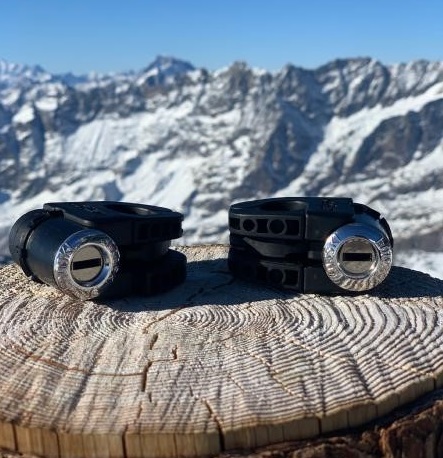 On a ski resort, after spending time on the slopes skiers will often head inside for a break in a restaurant or bar leaving their skis with everyone else’s on a rack outside. For this reason avid skier James Pittard decided not to buy himself expensive skis for fear that they would go missing, whether intentionally or unintentionally.
On a ski resort, after spending time on the slopes skiers will often head inside for a break in a restaurant or bar leaving their skis with everyone else’s on a rack outside. For this reason avid skier James Pittard decided not to buy himself expensive skis for fear that they would go missing, whether intentionally or unintentionally.
This led him to think about an easy to use, pocketable device that could lock both skis and poles simply together. Taking his idea to a design agency, the Loqski ski lock, with its high security combination lock that can be operated even with ski gloves on, was launched in a zinc-based material.
However, as sales were taking off the zinc-based material used couldn’t be manufactured quick enough to keep up with demand, until they discovered GV-5H, a glass fibre reinforced thermoplastic material that is often used in the automotive industry as it’s incredibly tough yet lightweight.
James then approached WMG, at the University of Warwick for help on a number of aspects of this looking into Grivory GV-5H, including testing the material, assessing the strength of the redesigned components in the assembly and giving advice on ways in which costs can be reduced during the manufacturing process.
Whilst it’s not possible to 3D print in Grivory GV-5H, researchers from WMG printed the prototype parts in strong engineering plastic with a carbon fibre infill using Markforged Mark 2 FDM printer that would reflect the strength of this material. These prints proved the suitability of Grivory GV-5H for this product.
They also assessed whether a redesigned barrel design component would fit into the assembly as changing just this one part would help reduce costs. They produced many 3D prints of the barrel component; these parts were then thoroughly tested not only for form and function but also to assess that it would fit with the other components in this existing assembly.
Being able to fully test the fitment of the new barrel design enabled Loqski to compare the cost of having to tool a completely redesigned product, which would be an excess of £50,000, or spending £7,000 for tooling just this barrel component and using it in the existing assembly.
“Loqski are now in a position where they are able to streamline manufacture. With less components to assemble, the assembly time has sped up and so manufacturing costs have been reduced. Loqski always had an ambition of keeping manufacture in the UK and by reducing manufacturing costs, we are pleased that we could assist them in doing that. We are thrilled to see them take their new and improved lock to the market, and hope that skiers this season will invest to keep their skis safe.” says Neil Jeffree, Innovation Manager at WMG, University of Warwick.
By reducing manufacturing costs Loqski is now able to produce a more cost-effective end product in higher volumes, which will put the company in better stead to work with distributors and have the product stocked by retailers worldwide. It has also led James to consider expanding the product’s reach even further.
“One of the things we’d now like to push is getting the new product into the ski rental market, where it can be hired out when skiers rent their skis. This is something we would never have considered with the zinc-based product as it was just too expensive.” says James Pittard, founder of Loqski.
ENDS
18 JANUARY 2022
NOTES TO EDITORS
High-res images available at:
https://warwick.ac.uk/services/communications/medialibrary/images/january_2022/img_2601.jpg
Caption: The Loqski Lock
Credit: Loqski
https://warwick.ac.uk/services/communications/medialibrary/images/january_2022/img_2612.jpg
Caption: The Loqski Lock
Credit: Loqski
For further information please contact:
Alice Scott
Media Relations Manager – Science
University of Warwick
Tel: +44 (0) 7920 531 221
E-mail: alice.j.scott@warwick.ac.uk
Wall climbing robot can reduce workplace accidents
- A wall climbing robot made by HausBots can reduce workplace accidents, as it can be used for inspection and maintenance tasks such as building and infrastructure inspection and surveying or even painting.
- However, to make sure the robot itself would work and is safe to use researchers from the WMG SME group helped the local business design and test the robot
- The robot is now on the market, after a four-year journey from a garage in Bournville to Singapore
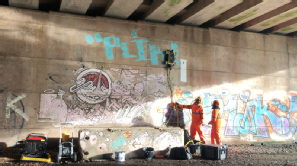 A novel wall climbing robot, built designed and created by Birmingham based HausBots with the help of WMG at the University of Warwick is on the market, and could reduce the number of workplace accidents.
A novel wall climbing robot, built designed and created by Birmingham based HausBots with the help of WMG at the University of Warwick is on the market, and could reduce the number of workplace accidents.
HausBots is a Birmingham based company who are on mission to use technology to protect and maintain the built environment. They have designed, built and created an innovative wall-climbing robot, that can climb vertical surfaces and be used for inspection and maintenance tasks such as building and infrastructure inspection and surveying or even painting.
The idea of the HausBots started in the co-founder’s garage, and with the help of the WMG SME team the robot was bought to life, as the team were able to help with building the prototype and testing the technology.
Four years ago, when the first prototype was developed researchers at WMG, University of Warwick worked with HausBots on the circuit motor controls and designed the system to help them get production ready thanks to the Product Innovation Accelerator scheme with CWLEP.
One the key uses of the HausBots is to help reduce the number of workplace accidents, in the US 85,000 workers fall from height every year, of which 700 of them will be fatal. The accidents also cost insurance companies over $1bn in claims every year, therefore not only does reducing the amount of accidents mean less injuries and trauma, but also means there’s a huge economic saving.
However, to ensure the robot itself doesn’t fall it had to undergo extensive electro-magnetic compatibility (EMC) testing to make sure the fans, which essentially attach it to the surface are functioning correctly.
The WMG SME team tested the robot by placing it in the EMC chamber and assessing how it responds to noise and to make sure it didn’t emit any unwanted noise into the atmosphere itself. Using amplifiers to simulate noise and analysers, the researchers were able to detect any unwanted interference and emissions with the robot and record results.
Dr David Norman, from the WMG SME group at the University of Warwick comments: “It has been a pleasure to be with HausBots and help them develop their product, the concept of the robot is incredible, and could save lives and reduce the number of workplace accidents.
“Our facilities and expertise have helped HausBots develop a market-ready product, which is now on the market and has carried out many jobs from painting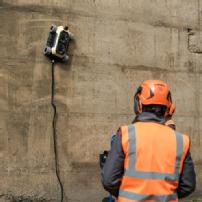 and cleaning the graffiti off the spaghetti junction in Birmingham. We hope to continue working with them in the future and can’t wait to see where they are this time next year.”
and cleaning the graffiti off the spaghetti junction in Birmingham. We hope to continue working with them in the future and can’t wait to see where they are this time next year.”
Jack Crone, CEO and Co-Founder of HausBots comments:
“The WMG SME group have helped us from day one, by helping us build the prototype all the way to making sure the robot safely sticks to the wall and carries out its job efficiently.
“We have worked tirelessly over the last 3 years to make HausBot, and we are incredibly excited to have sold our first one to a company in Singapore, we hope this is the first of many that will also help reduce numbers of workplace accidents.
“Going forward we hope to continue our work with WMG at the University of Warwick to make more robots for other uses that can reduce harm to humans.”
ENDS
14 DECEMBER 2021
NOTES TO EDITORS
High-res images available at:
https://warwick.ac.uk/services/communications/medialibrary/images/november_2021/graffiti_1.png
Caption: The HausBot robot in action covering up graffiti
Credit: HausBot
https://warwick.ac.uk/services/communications/medialibrary/images/november_2021/hausbot_house.png
Caption: The HausBot robot in action painting a house
Credit: HausBot
https://warwick.ac.uk/services/communications/medialibrary/images/november_2021/hausbot_in_action.jpg
Caption: The HausBot robot in action
Credit: HausBot
Video available to view at:
https://www.youtube.com/watch?v=b_hoPocYGAo
Caption: The robot covering up graffiti
Credit: HausBot
https://www.youtube.com/watch?v=VxDWJyLgBdM
Caption: The Robot in action in many ways
Credit: HausBot
For further information please contact:
Alice Scott
Media Relations Manager – Science
University of Warwick
Tel: +44 (0) 7920 531 221
E-mail: alice.j.scott@warwick.ac.uk
Heritage locomotive project picks up steam thanks to WMG
WMG’s SME Team has been supporting 3D Heritage and The A1 Steam Locomotive Trust (A1SLT) in their quest to revive steam rail travel.
3D Heritage and The A1 Steam Locomotive Trust’s (A1SLT) plan was to build a brand new Gresley class P2 steam locomotive, No. 2007 Prince of Wales at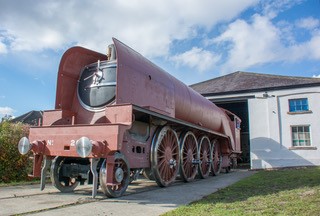 its Darlington Locomotive Works (DLW). The original class P2s were designed by Sir Nigel Gresley to haul trains on the arduous Edinburgh to Aberdeen route, however sadly the design was never fully developed to its full potential.
its Darlington Locomotive Works (DLW). The original class P2s were designed by Sir Nigel Gresley to haul trains on the arduous Edinburgh to Aberdeen route, however sadly the design was never fully developed to its full potential.
With new technology and expertise, they decided to resurrect the class P2s and bring their dream to life. However, there were some design and materials challenges, specifically with the original Lentz valve gear and cambox, that needed to be resolved.
WMG’s Innovation Manager, Dr Paul Lansdell, worked with the 3D Heritage and the Trust to create a CAD model that could be tested and amended. He also recommended the use of 3D printing in ABS plastic to create a one-third scale model of the cambox for the team to see if any changes were required before committing to manufacture. The box also featured a series of windows that enabled the engineering team to see what was happening with the valve mechanism on the inside.
Following the creation of the model, Dr Lansdell went on to explore the material grades, surface coatings and heat treatment which previously caused issues. This work has been extremely transformative, giving the project huge advantage for making reliable and durable valve gear. He has gone on to explore the use of 3D printing to create sand moulds to manufacture various parts of the locomotive. Developing patterns for sand casted metal parts can be extremely expensive and if there is an issue with the casting of the part it can be costly to start the process again.
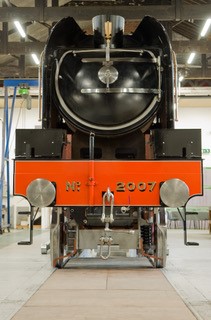 Martin Shepherd, Director of 3D Heritage said: “WMG’s support on this project has been invaluable. The advice we have received from Dr Lansdell has enabled us to look at options that we never would have considered before that have the potential to save the project tens of thousands of pounds.”
Martin Shepherd, Director of 3D Heritage said: “WMG’s support on this project has been invaluable. The advice we have received from Dr Lansdell has enabled us to look at options that we never would have considered before that have the potential to save the project tens of thousands of pounds.”
Dr Paul Lansdell, explained: “I have been honoured to work on this prestigious project which has allowed us to apply leading edge research and new techniques on a real-world business case.”
To find out more about the project contact Paul Lansdell: wmgsme@warwick.ac.uk
CO2 consuming concrete technology showcased at COP26 to be tested at University of Warwick
- Concrete contributes to 8% of global CO2e emissions, however Concrete4Change are on a mission to make concrete CO2 sinks rather than producers
- The CO2 sequestrating technology is being developed with the help of the School of Engineering and WMG SME group at the University of Warwick
- Researchers will help by testing the concrete which could revolutionise the concrete industry
- Concrete4Change won the award for Achieving Net Zero category at the UN Climate Change Cup last night at COP26
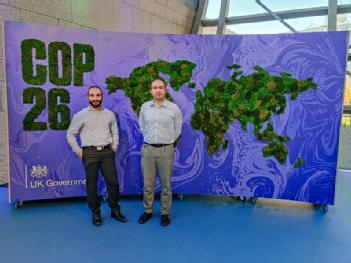 Technology developed by Concrete4Change that can make concrete a carbon sink rather than carbon producer will be trialled and tested by researchers from the University of Warwick. The technology which could revolutionise the concrete industry on a global scale, has been showcased and won an award at COP26.
Technology developed by Concrete4Change that can make concrete a carbon sink rather than carbon producer will be trialled and tested by researchers from the University of Warwick. The technology which could revolutionise the concrete industry on a global scale, has been showcased and won an award at COP26.
After water concrete is the most consumed material in the world, and accounts for 8% of global CO2e emissions. However, Concrete4Change Ltd. (C4C) are on a mission is to enable the concrete industry to transition from CO2 emitters to CO2 sinks, by developing a technology capable of removing significant amounts of CO2 from the atmosphere and absorbing it into concrete.
In fact, it was announced last night at COP26 that Concrete4Change have been announced as the winner of the Achieving Net Zero category of the 2021 UN Climate Change Challenge Awards.
The sequestration of CO2 results in the strength enhancement of concrete; therefore, reducing the amount of cement required to produce equivalent-strength concrete. Both CO2 sequestration and cement reduction can contribute to the reduction of concrete’s CO2 footprint. This technology has the potential to mitigate 2 billion tonnes of CO2e emissions, the equivalent of 4% of global CO2e emissions.
The School of Engineering and WMG centre High Value Manufacturing Catapult at the University of Warwick are proud to be supporting Concrete4Change, by undertaking essential testing for the company with the help of funding through Innovate UK and the DI4M programme.
Dr Reyes Garcia from the School of Engineering comments:
“As the world strives to reach zero-carbon goals, the construction industry and we civil engineers have a huge role to play to make concrete more sustainable. The cement we use to produce concrete contributes massively to CO2 emissions, and therefore we need to take drastic action now if the construction sector is to achieve its CO2 reduction goals. Here, at the School of Engineering, we are incredibly excited to support Concrete4Change by performing concrete technology and durability tests, which are critical to prove that the technology can be safely adopted by designers, contractors and concrete producers”.
Dave Myers from the WMG SME group at the University of Warwick comments:
“In order to make sure the concrete made by this innovative technology is as good, as if not better than previous standards we will be assisting Concrete4Change by completing testing and microscopical examination.
“Once testing has been completed the partnerships that C4C have made can help bring this technology to market and reinvent the concrete industry into a more sustainable and eco-friendlier one.”
Concrete4Change has built partnerships with other leading academic institutions as well as with some of the largest concrete producers in the world including Hanson Heidelberg, Kier, SIG, Morgan Sindall and Skanska.
Dr Sid Pourfalah, Founder and CEO of Concrete4Change comments:
“We are delighted to have the help to bring our unique technology to the market with help with the University of Warwick, not only are we showcasing our technology at COP26, but we have also been selected by Brazilian Ideiagov as one of the top 10 companies to tackle Latin America’s Net-Zero Challenge, bringing us hope that our technology is transferrable worldwide, and can help us shape tomorrow for future generations.”
C4C has also been selected by British Precast Federation as one of the top 3 most innovative companies and as one of the top 5 companies for Knowledge Transfer Network (KTN) Transforming Foundation Industries (TFI).
ENDS
11 NOVEMBER 2021
NOTES TO EDITORS
High-res images available at:
https://warwick.ac.uk/services/communications/medialibrary/images/november_2021/img_20211109_132635.jpg
Caption: From left to right, CTO Dr Michael Wise and Dr Sid Pourfalah, Founder and CEO of Concrete4Change at COP26
Credit: Conrete4Change
https://warwick.ac.uk/services/communications/medialibrary/images/november_2021/img_20211109_125514_003.jpg
Caption: COP26 flowers
Credit: Concrete4Change
Find out more about Concrete4Change here: https://www.concrete4change.com/
C4C selected for the prestigious Climate Challenge Cup (10th of November): https://lnkd.in/gfdmtWzZ
For further information please contact:
Alice Scott
Media Relations Manager – Science
University of Warwick
Tel: +44 (0) 7920 531 221
E-mail: alice.j.scott@warwick.ac.uk
WMG staff recognised by Ventilator Challenge UK
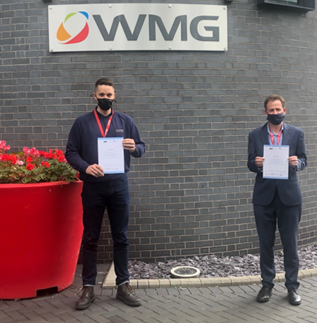 A group of WMG staff have been presented with personalised certificates of appreciation from the Ventilator Challenge UK in recognition of their hard work during the Covid19 pandemic.
A group of WMG staff have been presented with personalised certificates of appreciation from the Ventilator Challenge UK in recognition of their hard work during the Covid19 pandemic.
In summer 2020, WMG was part of a consortium that helped to produce a total of 13,437 Penlon ESO 2 and Smiths paraPAC ventilator devices for the NHS.
WMG staff operated a quality control facility in an automotive parts warehouse in Solihull with colleagues from other High Value Manufacturing Catapult centres - the National Composites Centre (NCC) and the Manufacturing Technology Centre (MTC). Together they worked around the clock tirelessly inspecting over eight million parts.
Dr Mark Swift, Head of WMG SME Group, said: “It’s once again great to see WMG involved in such a nationally important project. The team have done a fantastic job of showcasing our continuous ability to collaborate and support business. This recognition is well deserved and is a testament to our capabilities.”
The 12 strong team included Dave Cooper, Paul Charlton, Ricky Nestor, Lee Oldham, Divyesh Mistry, Max Raybone, Joe Ward, Luke Millage, Myles Vale, Simon Fox, Steve Leemoon and Mark Swift.
Read more about the WMG SME Group here: WMG SME Group | How can we help you? (warwick.ac.uk)
Mayor opens Ramfoam’s new headquarters as company embraces digital thanks to WMG, University of Warwick
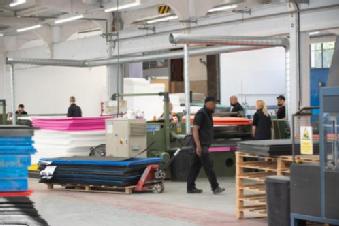
One of the first companies to sign up to a programme to improve the digital capabilities of smaller businesses has officially opened its new company headquarters and factory in Sandwell.
Andy Street, Mayor of the West Midlands and chair of the West Midlands Combined Authority (WMCA) cut the ribbon at Ramfoam’s new site on Haigne Road, Tividale which will see the business increase in size by 50 per cent.
Ramfoam, which makes foam products for the military and other organisations, was one of the first businesses to sign up to the West Midlands Made Smarter programme which is aimed at increasing the number of small and medium-sized enterprises (SMEs) adopting digital technology in manufacturing. Last year Ramfoam adapted its manufacturing practices to produce two million face visors a week at the height of the COVID-19 pandemic.
Made Smarter, which was officially launched in June, is headed up by the WMCA and the Department for Business, Energy and Industrial Strategy (BEIS).
Andy Street, the Mayor of the West Midlands said: “The West Midlands is a shining light for UK innovation, and that has become even more apparent throughout the pandemic.
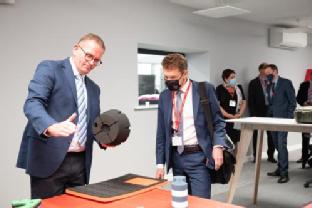 “That’s why, in partnership with BEIS, we set up the Made Smarter programme to help SMEs really make the most of our region’s digital capabilities.
“That’s why, in partnership with BEIS, we set up the Made Smarter programme to help SMEs really make the most of our region’s digital capabilities.
“It is therefore brilliant to see companies like Ramfoam not only taking part in the programme, but also the transformative effective it has had with their new expansion. The more companies that prosper like Ramfoam, the more jobs we’ll be able to create for local people.”
So far 85 companies have asked to join Made Smarter West Midlands and 58 have started the first stages of the programme. The year-long £1.9 million programme will see digital experts provide advice to businesses - like Ramfoam - on how to switch to advanced and automated technologies as well as working to improve employees’ overall digital skills.
Tim Mulqueen, Ramfoam’s sales director, said: “The Made Smarter programme is greatly assisting SMEs with their invaluable experience. Ramfoam is now actively working with Made Smarter to apply digital technologies to our business that will enable us to manufacture smarter and improve our efficiency, and in turn generate growth.
“I believe all West Midlands SME businesses could greatly benefit from support through Made Smarter; we all as SMEs need to challenge the way we do things in order to continuously improve and innovate.”
Ramfoam was helped by WMG at the University of Warwick to scale up production from 100,000 to two million face visors a week for the Government at the height of the pandemic.
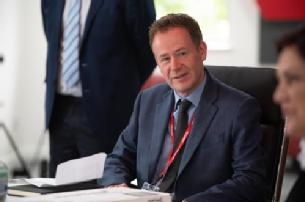 By creating a digital twin (a virtual model) Ramfoam was able to make 54 million visors over the last year. The company also signed up for WMG’s help to creating digital visualisation of its new factory, and now, as one of the first participants in Made Smarter West Midlands, will benefit from further assistance in adopting digital technology further.
By creating a digital twin (a virtual model) Ramfoam was able to make 54 million visors over the last year. The company also signed up for WMG’s help to creating digital visualisation of its new factory, and now, as one of the first participants in Made Smarter West Midlands, will benefit from further assistance in adopting digital technology further.
Dr Mark Swift, head of SME programmes at WMG, University of Warwick commented:
“The pandemic was a tough time for any business, and being able to flourish during it is certainly an achievement that Ramfoam has been able to do. We thoroughly enjoyed helping them drive up productivity and look forward to helping to transform Ramfoam further.
“It is incredibly exciting to see a West Midlands manufacturer doing so well, and we hope that more businesses will sign up to Made Smarter and continue to make the West Midlands a thriving manufacturing hub.”
The Coventry and Warwickshire Local Enterprise Partnership (CWLEP) Growth Hub is leading the one-year Made Smarter scheme with the region’s other Growth Hubs in Greater Birmingham and Solihull, the Black Country, Worcestershire, The Marches, and Stoke-on-Trent and Staffordshire on behalf of the WMCA and BEIS. The Growth Hubs are working closely with the WMCA and their strategic partners WMG, at the University of Warwick, and the Manufacturing Technology Centre (MTC) in Coventry.
Craig Humphrey, managing director of the CWLEP Growth Hub, said Ramfoam is a great example of a company best placed to take advantage of the Made Smarter scheme.
He said: “It’s fantastic that Ramfoam is one of the first firms to become part of the Made Smarter programme here in the West Midlands. It will help firms like Ramfoam develop innovative technology for the benefit of the region, as well as adopting new technology themselves to improve efficiency.
“Made Smarter will enable SMEs across the West Midlands receive the specialist support they need to embrace digital technology, and we are looking forward to more companies applying to Made Smarter and following in Ramfoam’s footsteps.”
Cllr Ian Brookfield, WMCA portfolio lead for economy and leader of City of Wolverhampton Council, said: “SMEs have felt the effects of the pandemic and have had to adapt to different ways of working as demonstrated by Ramfoam.
“Improved digital expertise gained through Made Smarter can help the region’s SMEs future-proof their practices, contributing to the economic prosperity of the region.”
To find out more about Made Smarter visit https://www.cwgrowthhub.co.uk/made-smarter-west-midlands
Made Smarter launches £1.9 million digital scheme with WMG to help West Midlands SMEs
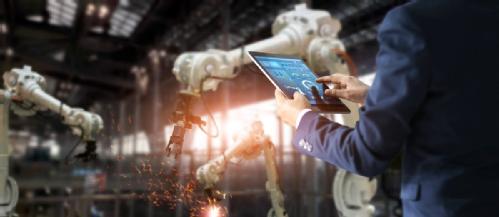 Made Smarter has launched a £1.9 million digital adoption push to drive growth in West Midlands manufacturing and engineering SMEs and help them boost productivity.
Made Smarter has launched a £1.9 million digital adoption push to drive growth in West Midlands manufacturing and engineering SMEs and help them boost productivity.
Digital experts will provide advice to businesses on how to switch to advanced and automated technologies as well as working to improve employees’ overall digital skills.
The Coventry and Warwickshire Local Enterprise Partnership (CWLEP) Growth Hub is leading the one-year Made Smarter scheme with its fellow Growth Hubs in Greater Birmingham and Solihull, the Black Country, Worcestershire Business Central, The Marches, and Stoke-on-Trent and Staffordshire on behalf of the West Midlands Combined Authority and the Department for Business, Energy and Industrial Strategy.
The West Midlands Growth Hubs are working closely with the West Midlands Combined Authority and their strategic partners WMG, at the University of Warwick and the Manufacturing Technology Centre (MTC) in Coventry to tap into the expertise of their digital manufacturing specialists.
Professor David Greenwood, CEO of WMG HVM Catapult centre, comments:
“Digitalisation for smaller companies needs a different approach than for larger companies. It isn’t about purchasing multi-million pound software systems – it’s about improvements in design tools, manufacturing, digitalising legacy plant and equipment and integration to supply chain systems.
“We are delighted to bring the expertise of WMG and the High Value Manufacturing Catapult to help transform the productivity of SMEs who are so critical to the West Midlands regional economy.”
Craig Humphrey, managing director of the CWLEP Growth Hub, said there are potentially 14,500 SME manufacturers in the region who could benefit from the National Made Smarter Movement. He said:
“All the Growth Hubs in the West Midlands are working together to contact SMEs in our areas who will benefit from this practical help.
“Digital technology can appear daunting and with the day-to-day efforts of owners and senior management teams to keep their businesses going during the pandemic, this kind of activity needs to be pushed to the upper end of their priorities.
“But we believe it is key to help SMEs in the advanced manufacturing and engineering sector to run more efficiently for their long-term future success.
“The Growth Hubs will be assessing each business that applies to make sure we provide them with the kind of specialist support they need, which in Coventry and Warwickshire could be in the fields of robotics and automation, and artificial intelligence since we are working with WMG and the MTC.
“We will then help SMEs to develop an action plan for adopting digital technology in their own detailed roadmap, which could involve participating in a leadership training programme, being offered a student placement, or receiving a match funded grant.
“The National Made Smarter Movement aims to entice SMEs that are not often reached through the usual business programmes and services, by transforming the digital tools within their companies, which in addition to upskilling their staff and creating jobs, will benefit the regional economy.”
Charlotte Horobin, Make UK Region Director – Midlands & East of England, said:
“The roll out of the Made Smarter Adoption programme across the West Midlands is great news for manufacturers, which we and our members welcome.
“Our 2020 Innovation Monitor highlighted that 18% of manufacturers in the West Midlands were not adopting industrial digital technologies, which we hope the programme will help address. Digital take-up will be key to boosting productivity as we come out of the current COVID crisis, creating more highly paid jobs and underpinning the region’s competitiveness.”
Neill Smith, Head of Manufacturing Support Services at the Manufacturing Technology Centre, said that the Made Smarter scheme perfectly complements its ongoing work to support manufacturing SMEs increase productivity, develop resilience, increase competitiveness and, ultimately, grow their business.
He said: “We help introduce digital systems to SMEs, that capture the right information at the right time, to enable them to make the right decisions and manage their companies more efficiently.
“From supporting the adoption of process control automation, robotics, and digitalisation tools, to helping SMEs with data or system integration and the adoption of augmented and virtual reality tools, we’re supporting companies to use digital data to drive digitally controlled equipment in the latest methods of manufacture.”
To register and find out more information, please visit http://bit.ly/MadeSmarterWestMidlands
ENDS
22 JUNE 2021
NOTES TO EDITORS
To find out more about MadeSmarter visit http://bit.ly/MadeSmarterWestMidlands
Made Smarter is a national movement to drive growth amongst UK makers and advance the UK economy. Backed by world renowned businesses and the UK government, it will improve the development and adoption of emerging technologies. Making a real, everyday difference to people from the boardroom to the factory floor.
Made Smarter was formed following a nationwide review into UK manufacturing that recommended three key changes: More ambitious leadership. More innovation in developing new technologies. And faster implementation and adoption of those technologies. We’ll be boosting the digital skills of industry leaders, bringing businesses and research development together to develop new technology, and helping makers embrace new digital tools. In doing so, we’ll inspire the next industrial revolution and make the UK a leader in digital technologies.
For further information please contact:
Alice Scott
Media Relations Manager - Science
University of Warwick
Tel: +44 (0) 7920 531 221
E-mail: alice.j.scott@warwick.ac.uk
